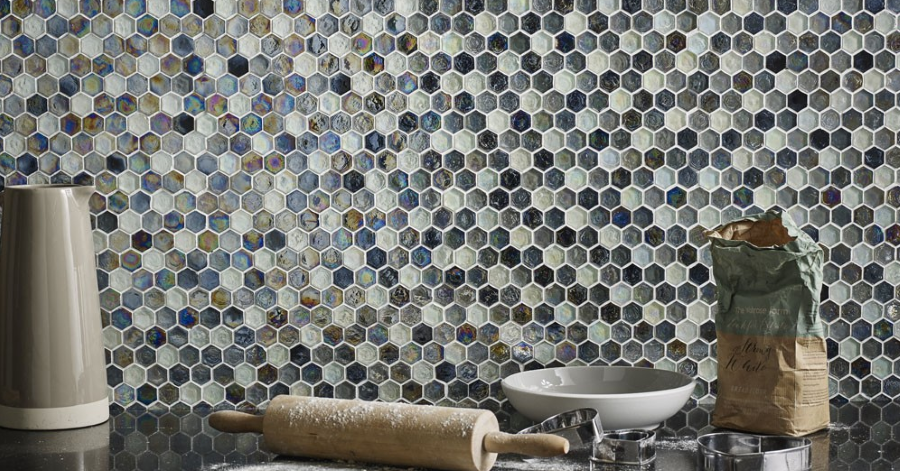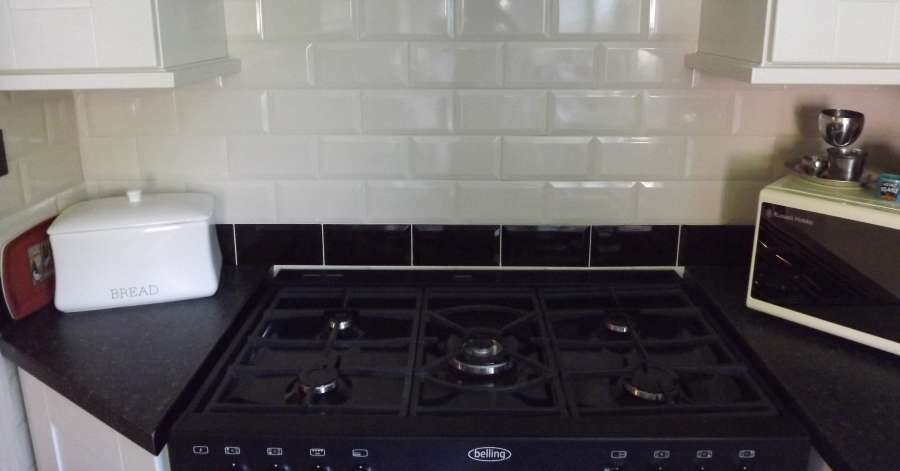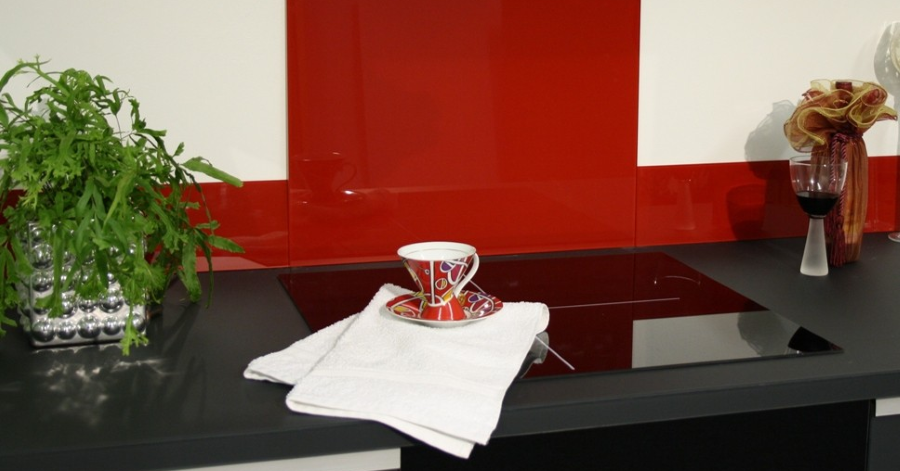Value your kitchen walls and don’t fancy repainting water-damaged areas every couple of months? It might be an idea to invest in a splashback or some sort. If you’re unsure as to what one is or how to go about choosing tiles for it, this handy 101 guide will provide you with the answers you need…
What’s A Splashback and Why Do I Need One?
The chances are that somewhere in your kitchen there’s a reasonably sized sink, as well as a food preparation area. As careful as you may be when making lunch or washing up, occasionally a bit of water will slosh against your paintwork or even worse, some unidentified viscous gloop from a hastily prepared meal indelibly stains your magnolia walls. This is where the humble splashback comes into its own. Put simply, a splashback is a section of tiles, usually positioned directly behind a sink or countertop and spanning about 300mm – 600mm of the way up the wall.
In most cases, splashbacks comprise of ceramic or porcelain tiles (or sometimes mosaics) but there’s no hard and fast rules as to what size or style you use. As long as they’re hardwearing and wipe clean, and complement your kitchen design aesthetic – you’re onto a winner! One of the most popular style of tiles for splashbacks are metro or subway tiles thanks to their timeless design, easy clean gloss finish, and the fact that they’re available in a myriad of colours. Whichever type you opt for though, you should make sure that they occupy a large enough areas to contain cooking splatters and water from the sink.
Types of Splashback Tiles
As mentioned, there really aren’t any rules as to what type of tiles you use for a kitchen splashback, aside from that they must be waterproof and non-porous. That, my friends, pretty much means that the world’s your lobster and you’re free to choose tiles that best accentuate your design scheme. That, my friends, pretty much means that the world’s your lobster and you’re free to choose tiles that best accentuate your design scheme. If you’re a frequent tile buyer or have merely been mooching round this site for some tile insight, you’ll probably be aware that tiles can come in all shapes and sizes, but the majority will be constructed from glass, metal, stone, or natural ceramics. Read on to get the lowdown on each type…
Mosaics
Mosaics have been around for an absolute age and are incredibly versatile. They’re great for accenting design schemes and creating centrepieces or border details and can be used on both walls and floors (dependant on the material they’re made from). Most commonly found in bathrooms and kitchens, they’re often chosen to create kitchen splashback from due to the fact that there’s so many different types available. Mosaics can be either square or oddly shaped and are constructed from materials such ceramics, porcelain, glass, and even natural stone like marble. Most commonly used for creating patterns and motifs, their diminutive stature makes them perfect for intricate designs and for combining different colors. Mosaics are also available in textured or iridescent variants (these vary in color when seen in different lights or from different angles). Check our handy How To Use Glass Mosaics, and Mesmerising Mosaics posts to learn more about these wondrous little tiles.
Ceramic Tiles
Just like their little brother mosaics, ceramic tiles are available in a myriad of styles and sizes, from the rustic charm of brick-like tiles such as Craquele, right through to the ultra-modern, splitface mosaic effect of Broadway. The only limit to your creativity when choosing splashback tiles is your imagination! Ceramic tiles easy on the eye and even easier to clean as most are glazed and have high gloss finished, meaning wiping them down is hassle-free. However, please be aware that some ceramic tiles are unglazed and are not suitable for direct contact with water and so therefore are not recommended for use in splashbacks. Thankfully, here at Tile Mountain, all our ceramic tiles are glazed and so you shouldn’t be presented with any headaches if opting to buy ceramic splashback tiles from us.
Porcelain Tiles
The makeup of porcelain tiles is a little different to their ceramic bredrin in that the clay they’re made from is baked a bit longer and at a at a higher temperature than other types of ceramic tile. The result is that porcelain tiles are denser. No, we don’t mean that they’d be rubbish on Pointless – the clay they’re made from is actually compacted more thus making them stronger and more hardwearing. For this reason, porcelain tiles are more often used used on floors. That’s not to say that you can’t opt for porcelain splashback tiles however, in fact, they’re perhaps even more of a better bet than plain old ceramic tiles given that porcelain is good at resisting both stains and moisture. Another plus is that the colour pigment that is used in porcelain tiles is mixed throughout the entire tile, meaning that if the tile is scratched or chipped, the damage will be less noticeable than it would be with other ceramic tiles.
Glass Tiles
Glass tiles are made from both new and recycled glass and offer higher durability than other styles do. These tiles are come in a range of colours, shapes, and sizes and are quite environmentally friendly as they are mainly constructed from re-purposed glass. In addition to traditional clear and shiny glass, a number of finishes for glass tiles are available. Opalescent finishes offer either a reflective backing or an opaque colour blended into the tile itself, whilst opaque (or sandblasted) tiles typically have a rough finish. Glass tiles can be solid in colour or patterned in a variety of ways. They can be cut into all manner of shapes such as squares, triangles, rectangles, and octagons too. Smaller, lightweight glass tiles work well for ornamental installations such as splashback areas. Since glass tiles are largely translucent, strategic placement of these tiles will allow either natural or artificial light to shine through them, creating an ethereal, almost otherworldly glow. Cosmic.
Vitreous Tiles
Sounds mysterious and slightly daunting this one but vitreous tiles, are merely tiles with a low moisture absorption rate. Also known as frost-proof tiles, these vitreous fellas absorb less than three percent moisture, making them ideal for kitchen use, where there’s a good chance that they’ll come in contact with water and steam. Vitreous tiles usually sport a shiny surface area, soft protective glaze, and a ridged underside to help with adhesion. A lot of vitreous tiles feature durable, non-slip surfaces – admirable qualities in a splashback – and pre-made vitreous mosaics are available in pre-cut sheets that can be directly installed onto walls. You can see just how by watching our useful video on laying mosaics.
Natural Stone Tiles
Natural stone tiles are exactly that – tiles made from stone that has been hewn from the earth. As you’d expect,natural stone tiles are very very durable and because they are not man made, have their own unique beauty. Often a little pricier than ceramic or porcelain tiles, natural stone tiles make a great choice for splashbacks for those wanting to create an opulent, high-end aesthetic. The table below explains the makeup and attributes of some popular natural stone products:

How To Choose Splashback Tiles
Be aware that most natural stone products will require sealing once installed in order to make them fully water resistant and to provide longevity. The finish of the natural stone will determine what product is required for sealing – polished natural stone requires sealing with Fila MP90, whereas natural stone with a matt finish requires Fila W68
The fact that our vast range of splashback are relatively inexpensive does not necessarily mean they are low quality. Prices vary considerably from the high street where some retailers sell this type of tile at nearly double the price of those sold by online retailers. The best way to know which tile is worth the price is by getting samples of the tiles to compare their quality. When you receive your samples, the finish should not have marking, dimples, scratches, or imperfections on the surface. The base colour of the tiles you’ve sampled should be clean and crisp and free from fading.
If opting for quartz stone tiles, the quartz pieces embedded within should be more or less equally distributed across the tile (you will need a full tile sample to determine this however). Natural stone tiles will feature some variance between each piece – textures and veining should appear randomly spaced and differ from tile to tile. In order to fully appreciate the natural beauty of natural products we’d advise requesting a full tile sample before you buy.
Dean heads up the content team here at Tile Mountain, commissioning, editing and sometimes even writing some of the incredibly useful and entertaining content we bring to you on a regular basis. With a background in consumer journalism and a raft of content marketing experience gained from working with huge brands spanning mobile tech and automotive, right through to professional sports and lifestyle sectors, he knows a thing or two about creating content that people love to engage with. Dean also holds the mantle of being our resident grammar pedant, but when he’s not getting angry about dangling participles he spends his spare time going to gigs, watching his beloved Stoke City FC, and adding to his collection of deadstock adidas trainers.








